2014 NISSAN CUBE warning light
[x] Cancel search: warning lightPage 10 of 332
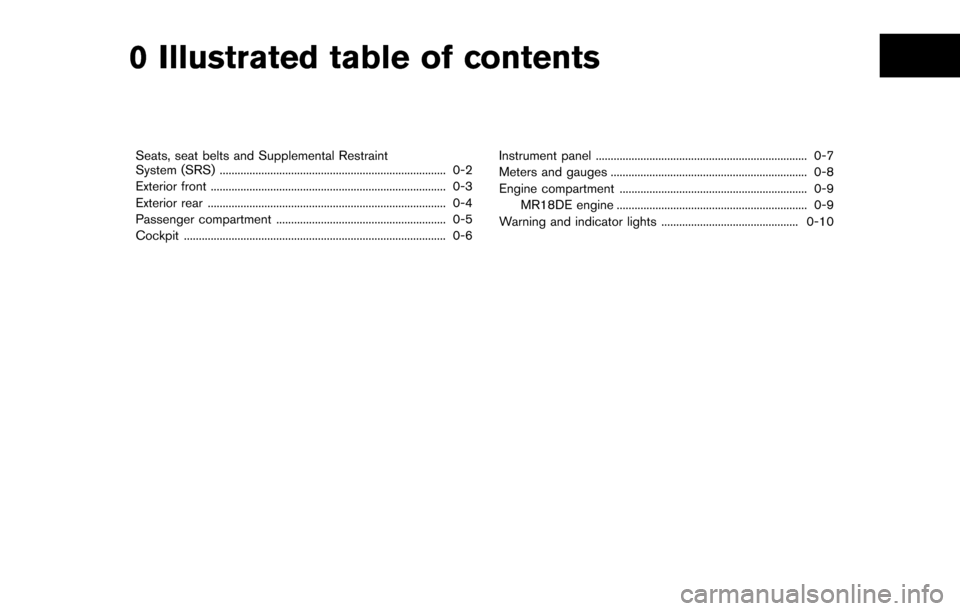
0 Illustrated table of contents
Seats, seat belts and Supplemental Restraint
System (SRS) ........................................................................\
.... 0-2
Exterior front ........................................................................\
....... 0-3
Exterior rear ........................................................................\
........ 0-4
Passenger compartment ......................................................... 0-5
Cockpit ........................................................................\
................ 0-6 Instrument panel ....................................................................... 0-7
Meters and gauges .................................................................. 0-8
Engine compartment ............................................................... 0-9
MR18DE engine ................................................................ 0-9
Warning and indicator lights .............................................. 0-10
Page 16 of 332
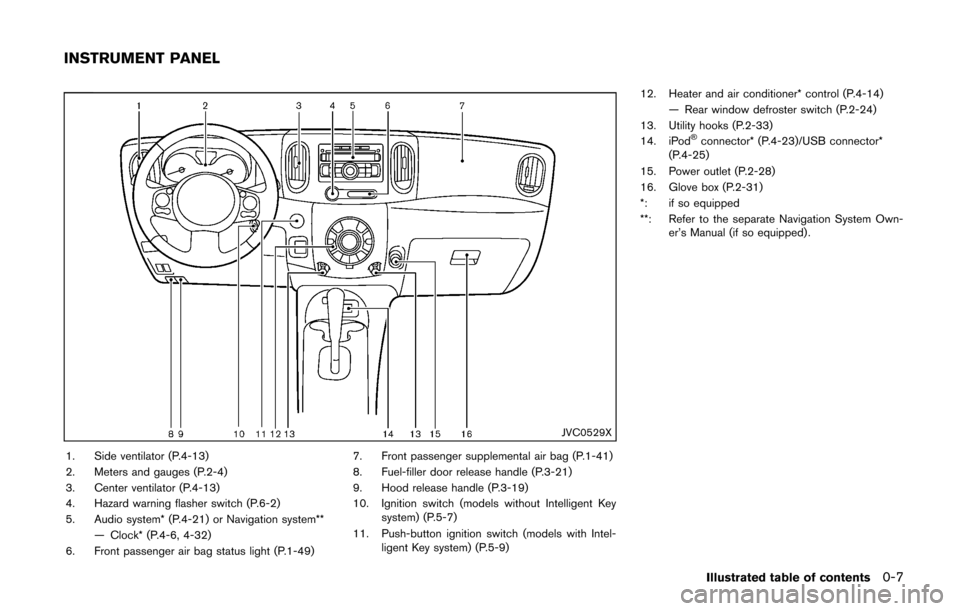
JVC0529X
1. Side ventilator (P.4-13)
2. Meters and gauges (P.2-4)
3. Center ventilator (P.4-13)
4. Hazard warning flasher switch (P.6-2)
5. Audio system* (P.4-21) or Navigation system**— Clock* (P.4-6, 4-32)
6. Front passenger air bag status light (P.1-49) 7. Front passenger supplemental air bag (P.1-41)
8. Fuel-filler door release handle (P.3-21)
9. Hood release handle (P.3-19)
10. Ignition switch (models without Intelligent Key
system) (P.5-7)
11. Push-button ignition switch (models with Intel- ligent Key system) (P.5-9) 12. Heater and air conditioner* control (P.4-14)
— Rear window defroster switch (P.2-24)
13. Utility hooks (P.2-33)
14. iPod
®connector* (P.4-23)/USB connector*
(P.4-25)
15. Power outlet (P.2-28)
16. Glove box (P.2-31)
*: if so equipped
**: Refer to the separate Navigation System Own- er’s Manual (if so equipped) .
Illustrated table of contents0-7
INSTRUMENT PANEL
Page 17 of 332
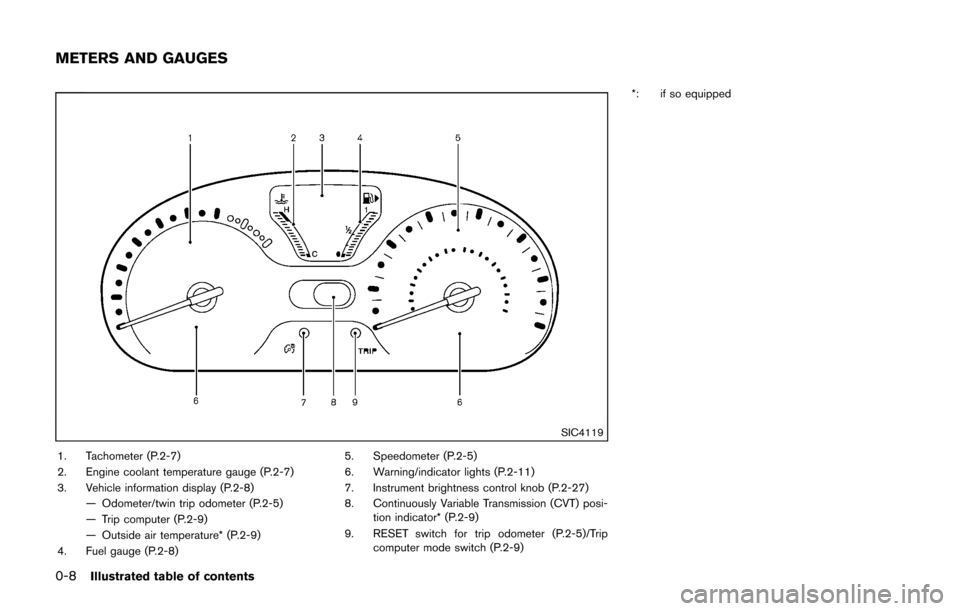
0-8Illustrated table of contents
SIC4119
1. Tachometer (P.2-7)
2. Engine coolant temperature gauge (P.2-7)
3. Vehicle information display (P.2-8)— Odometer/twin trip odometer (P.2-5)
— Trip computer (P.2-9)
— Outside air temperature* (P.2-9)
4. Fuel gauge (P.2-8) 5. Speedometer (P.2-5)
6. Warning/indicator lights (P.2-11)
7. Instrument brightness control knob (P.2-27)
8. Continuously Variable Transmission (CVT) posi-
tion indicator* (P.2-9)
9. RESET switch for trip odometer (P.2-5)/Trip computer mode switch (P.2-9) *: if so equipped
METERS AND GAUGES
Page 19 of 332
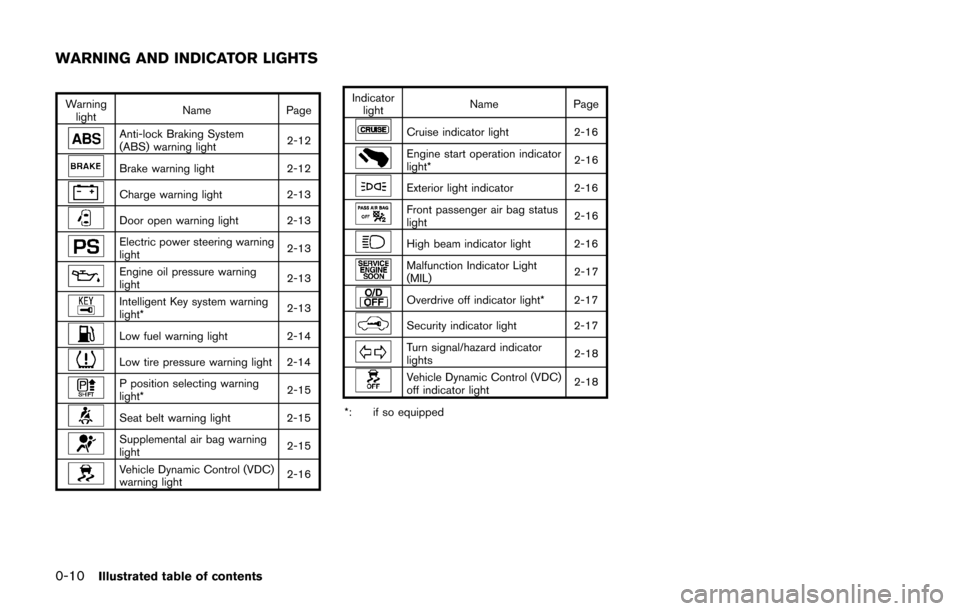
0-10Illustrated table of contents
Warninglight Name
Page
Anti-lock Braking System
(ABS) warning light 2-12
Brake warning light
2-12
Charge warning light2-13
Door open warning light 2-13
Electric power steering warning
light 2-13
Engine oil pressure warning
light2-13
Intelligent Key system warning
light*
2-13
Low fuel warning light
2-14
Low tire pressure warning light 2-14
P position selecting warning
light* 2-15
Seat belt warning light 2-15
Supplemental air bag warning
light2-15
Vehicle Dynamic Control (VDC)
warning light2-16Indicator
light Name
Page
Cruise indicator light 2-16
Engine start operation indicator
light* 2-16
Exterior light indicator
2-16
Front passenger air bag status
light 2-16
High beam indicator light 2-16
Malfunction Indicator Light
(MIL)2-17
Overdrive off indicator light* 2-17
Security indicator light 2-17
Turn signal/hazard indicator
lights2-18
Vehicle Dynamic Control (VDC)
off indicator light2-18
*: if so equipped
WARNING AND INDICATOR LIGHTS
Page 20 of 332
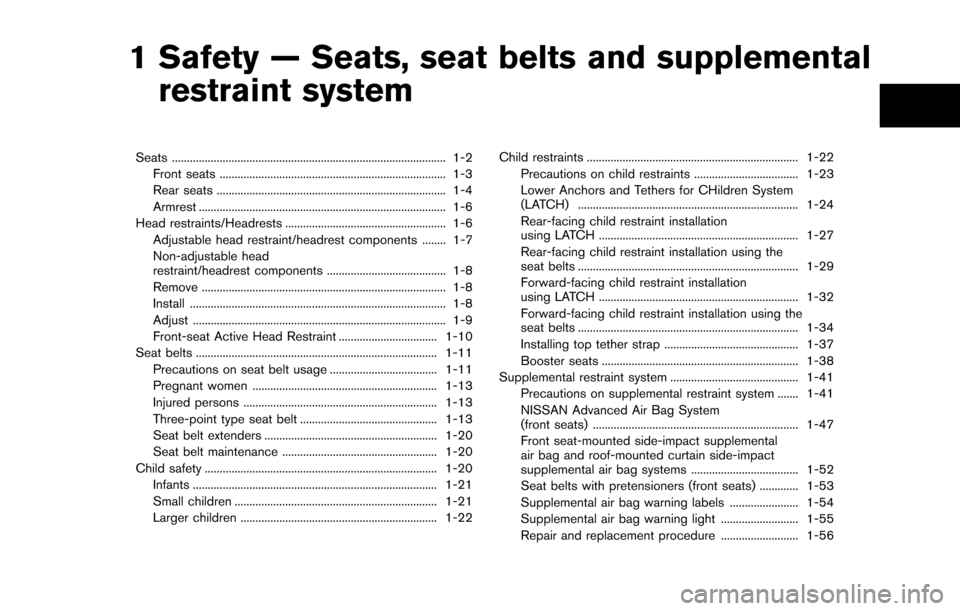
1 Safety — Seats, seat belts and supplementalrestraint system
Seats ........................................................................\
.................... 1-2
Front seats ........................................................................\
.... 1-3
Rear seats ........................................................................\
..... 1-4
Armrest ........................................................................\
........... 1-6
Head restraints/Headrests ...................................................... 1-6 Adjustable head restraint/headrest components ........ 1-7
Non-adjustable head
restraint/headrest components ........................................ 1-8
Remove ........................................................................\
.......... 1-8
Install ........................................................................\
.............. 1-8
Adjust ........................................................................\
............. 1-9
Front-seat Active Head Restraint ................................. 1-10
Seat belts ........................................................................\
......... 1-11
Precautions on seat belt usage .................................... 1-11
Pregnant women .............................................................. 1-13
Injured persons ................................................................. 1-13
Three-point type seat belt .............................................. 1-13
Seat belt extenders .......................................................... 1-20
Seat belt maintenance .................................................... 1-20
Child safety ........................................................................\
...... 1-20 Infants ........................................................................\
.......... 1-21
Small children .................................................................... 1-21
Larger children .................................................................. 1-22 Child restraints ....................................................................... 1-22
Precautions on child restraints ................................... 1-23
Lower Anchors and Tethers for CHildren System
(LATCH) ........................................................................\
.. 1-24
Rear-facing child restraint installation
using LATCH ................................................................... 1-27
Rear-facing child restraint installation using the
seat belts ........................................................................\
.. 1-29
Forward-facing child restraint installation
using LATCH ................................................................... 1-32
Forward-facing child restraint installation using the
seat belts ........................................................................\
.. 1-34
Installing top tether strap ............................................. 1-37
Booster seats .................................................................. 1-38
Supplemental restraint system ........................................... 1-41 Precautions on supplemental restraint system ....... 1-41
NISSAN Advanced Air Bag System
(front seats) ..................................................................... 1-47
Front seat-mounted side-impact supplemental
air bag and roof-mounted curtain side-impact
supplemental air bag systems .................................... 1-52
Seat belts with pretensioners (front seats) ............. 1-53
Supplemental air bag warning labels ....................... 1-54
Supplemental air bag warning light .......................... 1-55
Repair and replacement procedure .......................... 1-56
Page 31 of 332
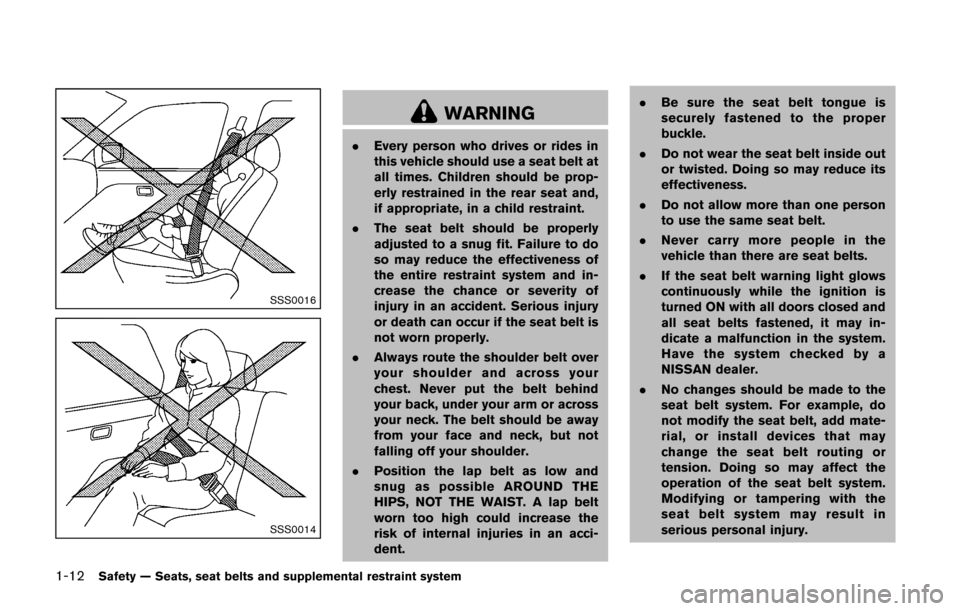
1-12Safety — Seats, seat belts and supplemental restraint system
SSS0016
SSS0014
WARNING
.Every person who drives or rides in
this vehicle should use a seat belt at
all times. Children should be prop-
erly restrained in the rear seat and,
if appropriate, in a child restraint.
. The seat belt should be properly
adjusted to a snug fit. Failure to do
so may reduce the effectiveness of
the entire restraint system and in-
crease the chance or severity of
injury in an accident. Serious injury
or death can occur if the seat belt is
not worn properly.
. Always route the shoulder belt over
your shoulder and across your
chest. Never put the belt behind
your back, under your arm or across
your neck. The belt should be away
from your face and neck, but not
falling off your shoulder.
. Position the lap belt as low and
snug as possible AROUND THE
HIPS, NOT THE WAIST. A lap belt
worn too high could increase the
risk of internal injuries in an acci-
dent. .
Be sure the seat belt tongue is
securely fastened to the proper
buckle.
. Do not wear the seat belt inside out
or twisted. Doing so may reduce its
effectiveness.
. Do not allow more than one person
to use the same seat belt.
. Never carry more people in the
vehicle than there are seat belts.
. If the seat belt warning light glows
continuously while the ignition is
turned ON with all doors closed and
all seat belts fastened, it may in-
dicate a malfunction in the system.
Have the system checked by a
NISSAN dealer.
. No changes should be made to the
seat belt system. For example, do
not modify the seat belt, add mate-
rial, or install devices that may
change the seat belt routing or
tension. Doing so may affect the
operation of the seat belt system.
Modifying or tampering with the
seat belt system may result in
serious personal injury.
Page 49 of 332
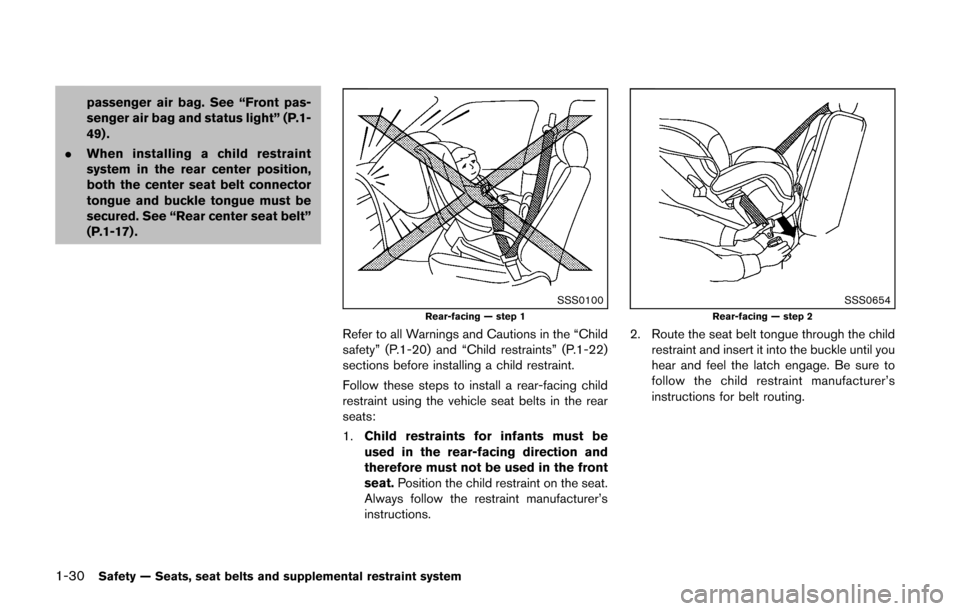
1-30Safety — Seats, seat belts and supplemental restraint system
passenger air bag. See “Front pas-
senger air bag and status light” (P.1-
49) .
. When installing a child restraint
system in the rear center position,
both the center seat belt connector
tongue and buckle tongue must be
secured. See “Rear center seat belt”
(P.1-17) .
SSS0100Rear-facing — step 1
Refer to all Warnings and Cautions in the “Child
safety” (P.1-20) and “Child restraints” (P.1-22)
sections before installing a child restraint.
Follow these steps to install a rear-facing child
restraint using the vehicle seat belts in the rear
seats:
1.Child restraints for infants must be
used in the rear-facing direction and
therefore must not be used in the front
seat. Position the child restraint on the seat.
Always follow the restraint manufacturer’s
instructions.
SSS0654Rear-facing — step 2
2. Route the seat belt tongue through the child restraint and insert it into the buckle until you
hear and feel the latch engage. Be sure to
follow the child restraint manufacturer’s
instructions for belt routing.
Page 53 of 332
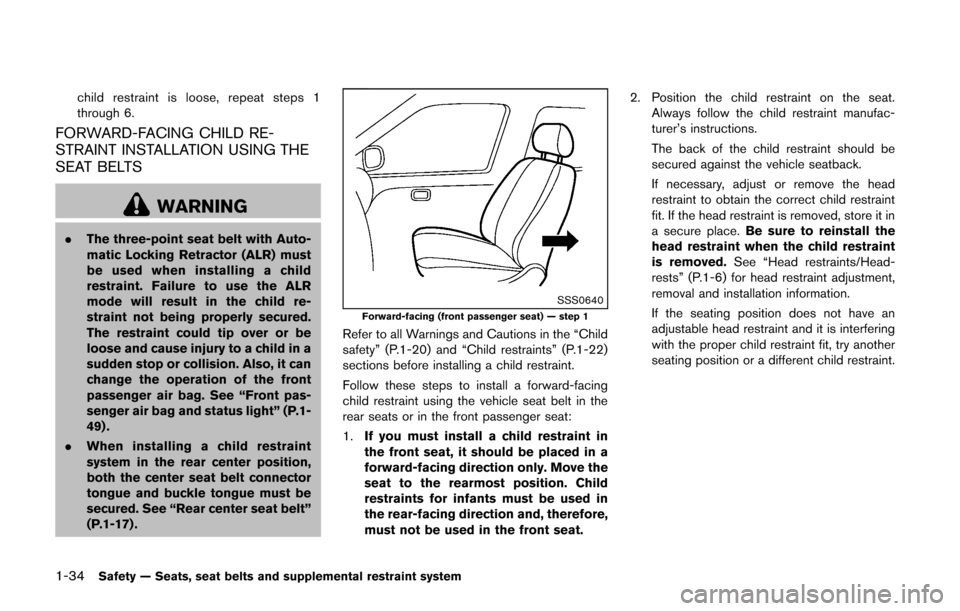
1-34Safety — Seats, seat belts and supplemental restraint system
child restraint is loose, repeat steps 1
through 6.
FORWARD-FACING CHILD RE-
STRAINT INSTALLATION USING THE
SEAT BELTS
WARNING
.The three-point seat belt with Auto-
matic Locking Retractor (ALR) must
be used when installing a child
restraint. Failure to use the ALR
mode will result in the child re-
straint not being properly secured.
The restraint could tip over or be
loose and cause injury to a child in a
sudden stop or collision. Also, it can
change the operation of the front
passenger air bag. See “Front pas-
senger air bag and status light” (P.1-
49) .
. When installing a child restraint
system in the rear center position,
both the center seat belt connector
tongue and buckle tongue must be
secured. See “Rear center seat belt”
(P.1-17) .
SSS0640Forward-facing (front passenger seat) — step 1
Refer to all Warnings and Cautions in the “Child
safety” (P.1-20) and “Child restraints” (P.1-22)
sections before installing a child restraint.
Follow these steps to install a forward-facing
child restraint using the vehicle seat belt in the
rear seats or in the front passenger seat:
1. If you must install a child restraint in
the front seat, it should be placed in a
forward-facing direction only. Move the
seat to the rearmost position. Child
restraints for infants must be used in
the rear-facing direction and, therefore,
must not be used in the front seat. 2. Position the child restraint on the seat.
Always follow the child restraint manufac-
turer’s instructions.
The back of the child restraint should be
secured against the vehicle seatback.
If necessary, adjust or remove the head
restraint to obtain the correct child restraint
fit. If the head restraint is removed, store it in
a secure place. Be sure to reinstall the
head restraint when the child restraint
is removed. See “Head restraints/Head-
rests” (P.1-6) for head restraint adjustment,
removal and installation information.
If the seating position does not have an
adjustable head restraint and it is interfering
with the proper child restraint fit, try another
seating position or a different child restraint.